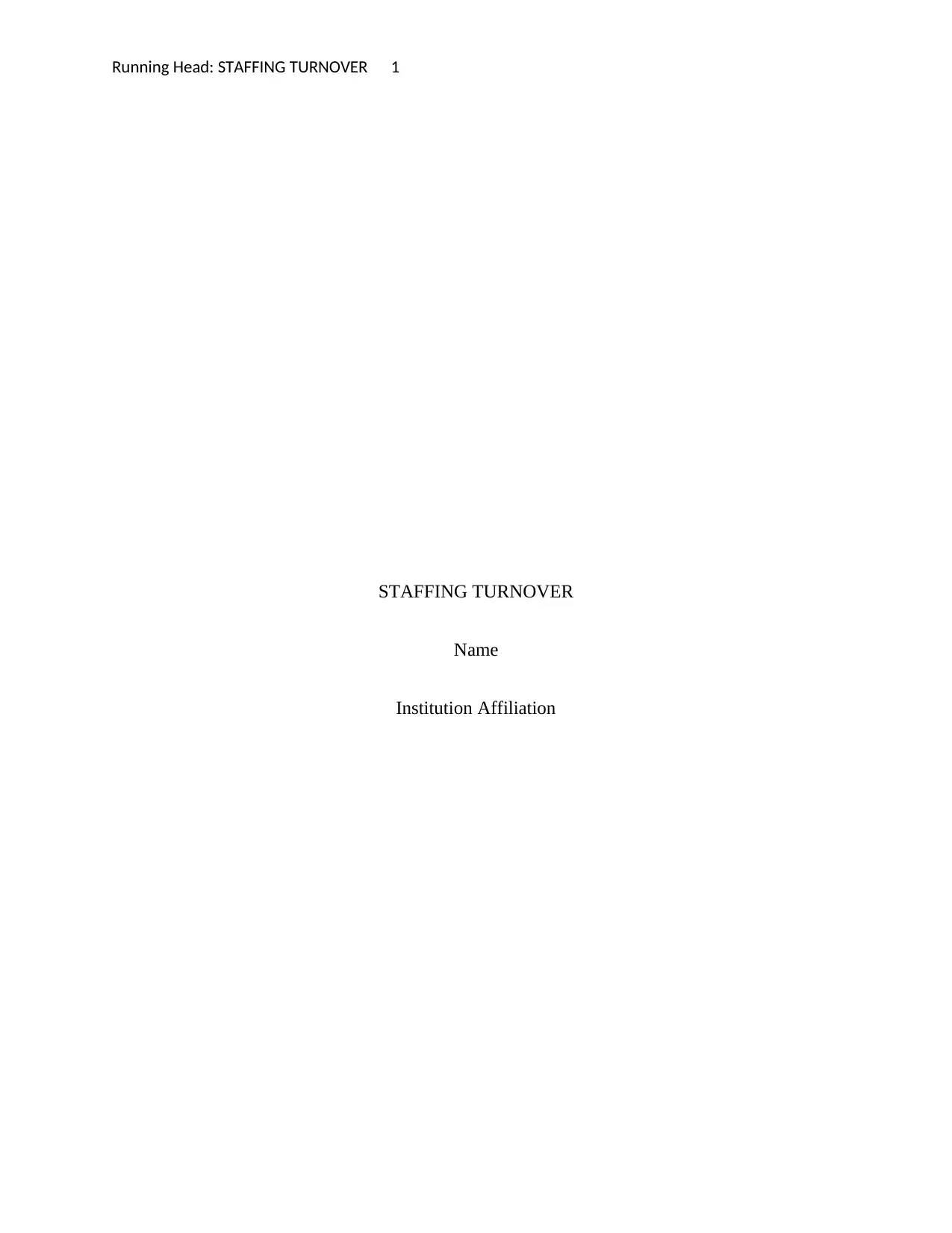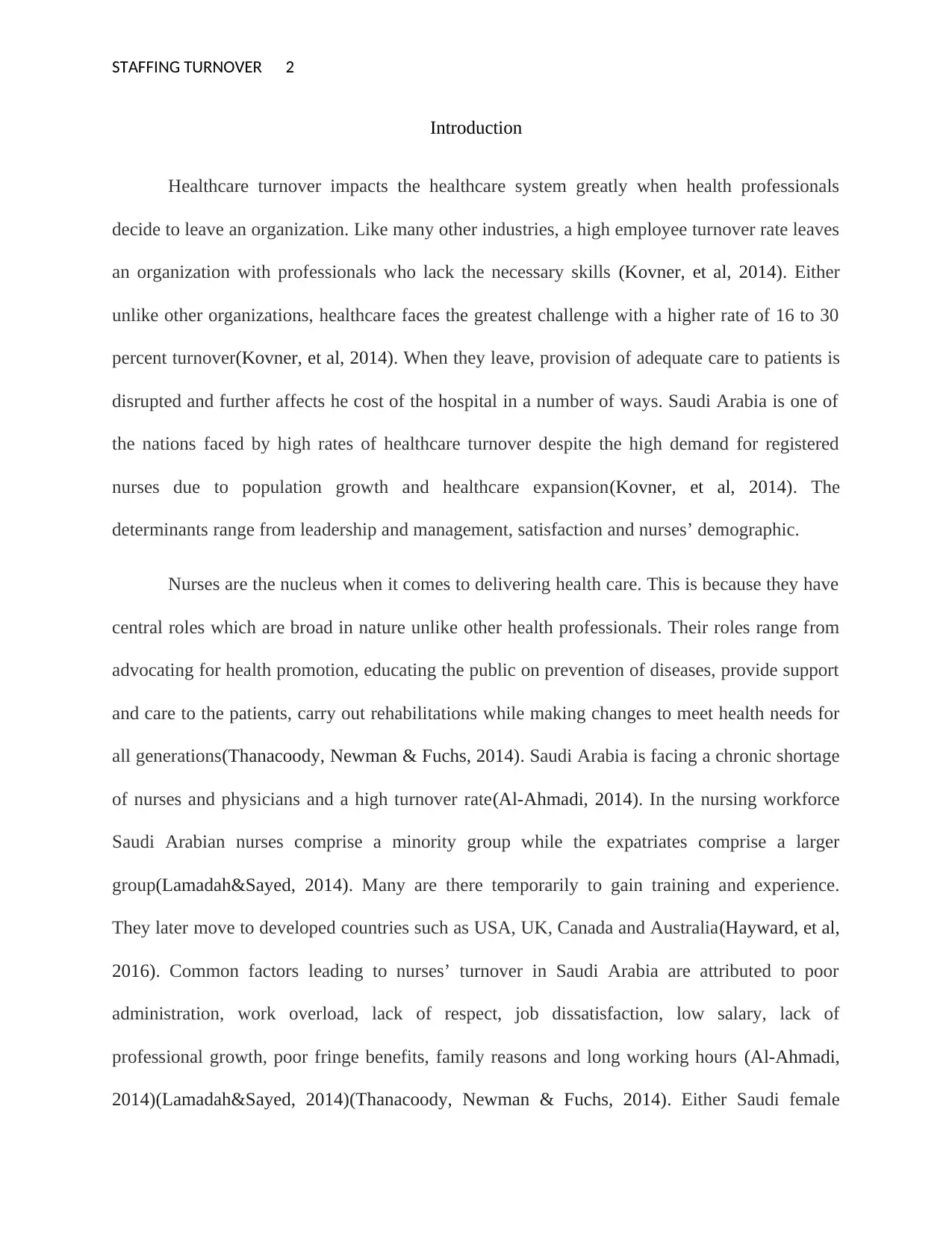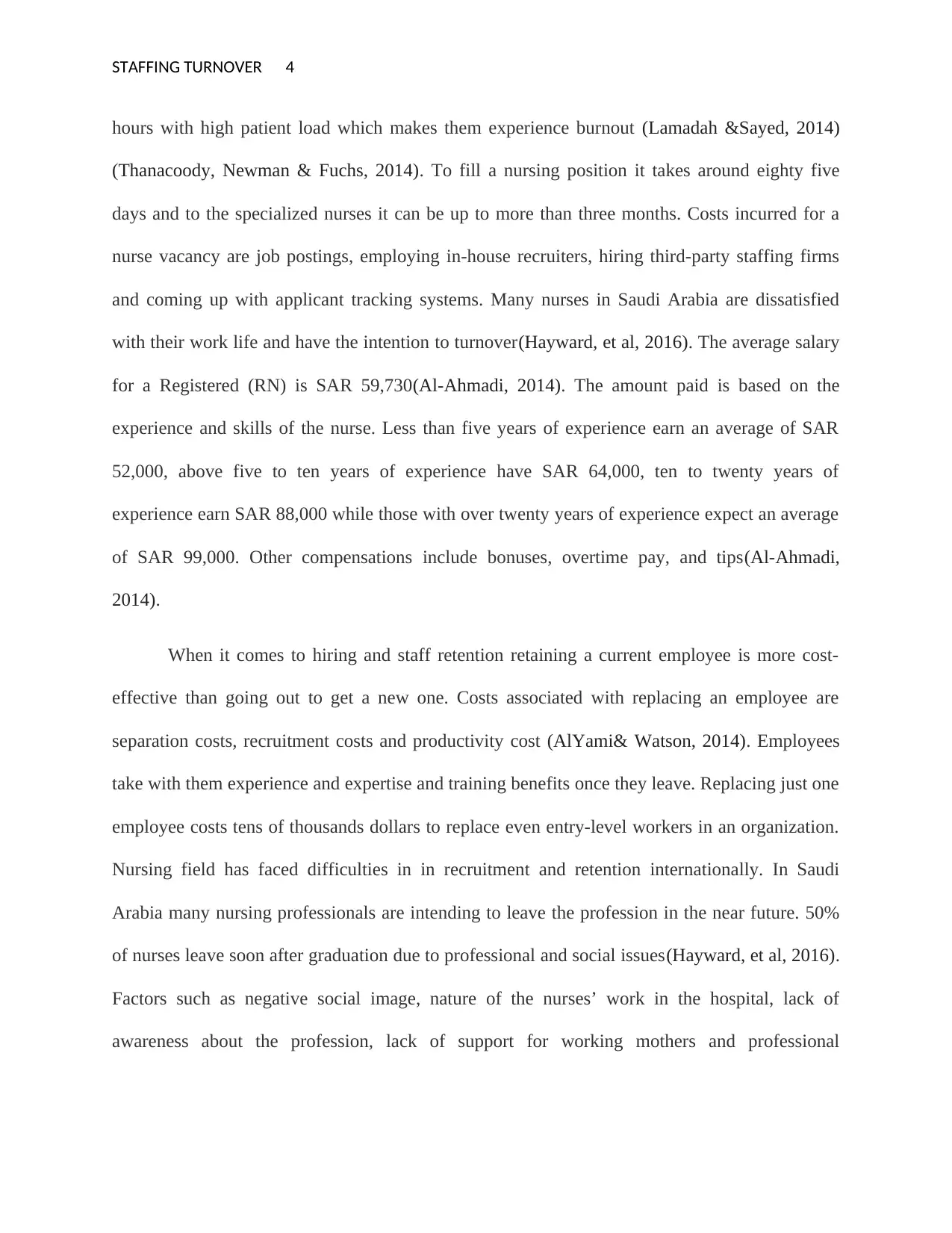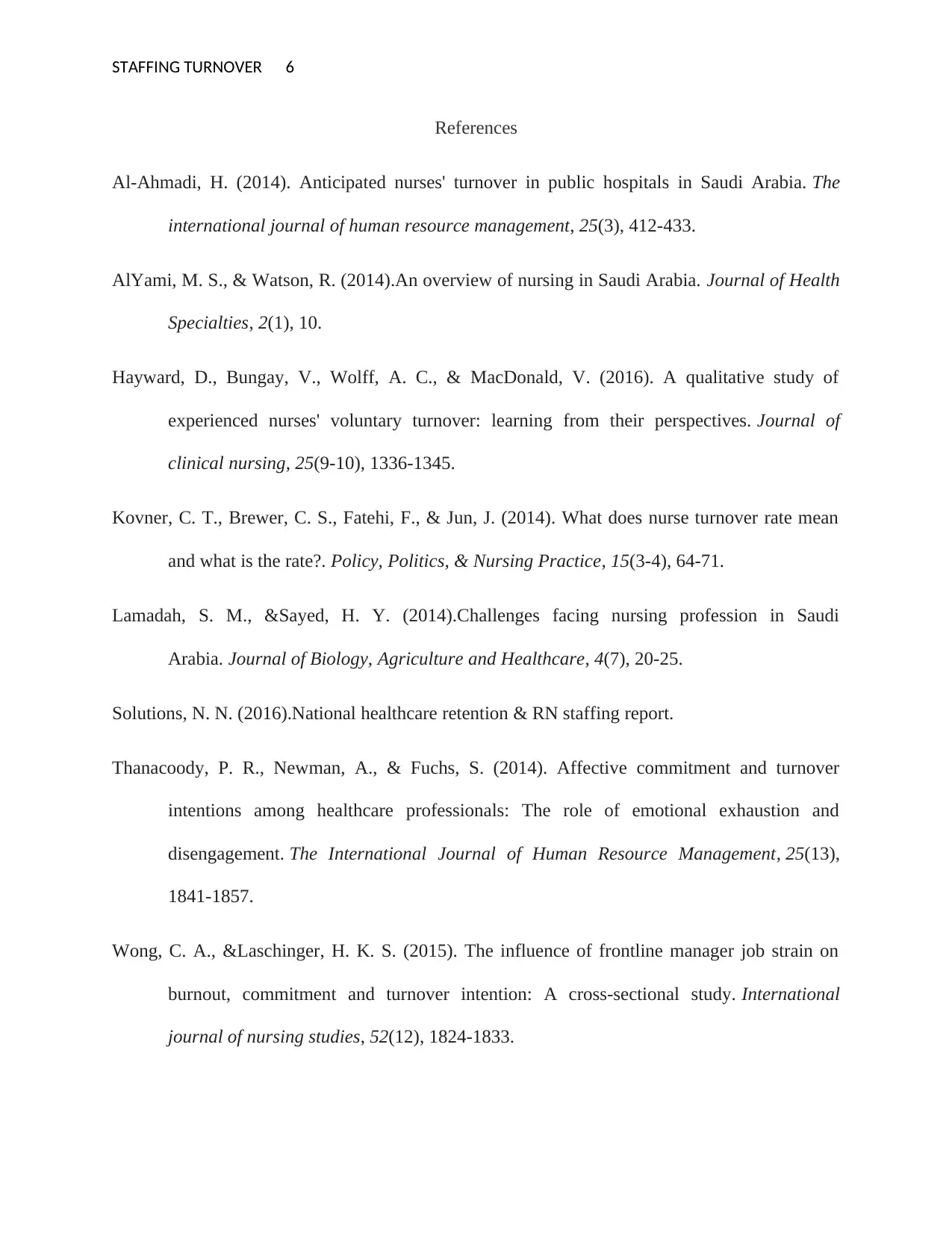Staffing Turnover Challenges and Solutions in Saudi Arabian Healthcare
VerifiedAdded on 2023/05/29
|6
|1667
|385
Report
AI Summary
This report delves into the critical issue of healthcare staffing turnover in Saudi Arabia, highlighting its significant impact on the healthcare system. The high turnover rates, particularly among nurses, are attributed to factors such as leadership and management issues, job dissatisfaction, work overload, and cultural factors. The report emphasizes the financial implications of employee turnover, including recruitment, training, and lost productivity costs, with nurse turnover costing millions annually. It also addresses the challenges in recruiting and retaining nurses, influenced by negative social perceptions, lack of professional development, and insufficient support for working mothers. The conclusion underscores the need to address the needs of nurses, who constitute the majority of the healthcare workforce, and implement measures to reduce turnover costs and improve overall healthcare delivery in Saudi Arabia. Access this student-contributed report and more on Desklib for comprehensive insights.

Running Head: STAFFING TURNOVER 1
STAFFING TURNOVER
Name
Institution Affiliation
STAFFING TURNOVER
Name
Institution Affiliation
Paraphrase This Document
Need a fresh take? Get an instant paraphrase of this document with our AI Paraphraser

STAFFING TURNOVER 2
Introduction
Healthcare turnover impacts the healthcare system greatly when health professionals
decide to leave an organization. Like many other industries, a high employee turnover rate leaves
an organization with professionals who lack the necessary skills (Kovner, et al, 2014). Either
unlike other organizations, healthcare faces the greatest challenge with a higher rate of 16 to 30
percent turnover(Kovner, et al, 2014). When they leave, provision of adequate care to patients is
disrupted and further affects he cost of the hospital in a number of ways. Saudi Arabia is one of
the nations faced by high rates of healthcare turnover despite the high demand for registered
nurses due to population growth and healthcare expansion(Kovner, et al, 2014). The
determinants range from leadership and management, satisfaction and nurses’ demographic.
Nurses are the nucleus when it comes to delivering health care. This is because they have
central roles which are broad in nature unlike other health professionals. Their roles range from
advocating for health promotion, educating the public on prevention of diseases, provide support
and care to the patients, carry out rehabilitations while making changes to meet health needs for
all generations(Thanacoody, Newman & Fuchs, 2014). Saudi Arabia is facing a chronic shortage
of nurses and physicians and a high turnover rate(Al-Ahmadi, 2014). In the nursing workforce
Saudi Arabian nurses comprise a minority group while the expatriates comprise a larger
group(Lamadah&Sayed, 2014). Many are there temporarily to gain training and experience.
They later move to developed countries such as USA, UK, Canada and Australia(Hayward, et al,
2016). Common factors leading to nurses’ turnover in Saudi Arabia are attributed to poor
administration, work overload, lack of respect, job dissatisfaction, low salary, lack of
professional growth, poor fringe benefits, family reasons and long working hours (Al-Ahmadi,
2014)(Lamadah&Sayed, 2014)(Thanacoody, Newman & Fuchs, 2014). Either Saudi female
Introduction
Healthcare turnover impacts the healthcare system greatly when health professionals
decide to leave an organization. Like many other industries, a high employee turnover rate leaves
an organization with professionals who lack the necessary skills (Kovner, et al, 2014). Either
unlike other organizations, healthcare faces the greatest challenge with a higher rate of 16 to 30
percent turnover(Kovner, et al, 2014). When they leave, provision of adequate care to patients is
disrupted and further affects he cost of the hospital in a number of ways. Saudi Arabia is one of
the nations faced by high rates of healthcare turnover despite the high demand for registered
nurses due to population growth and healthcare expansion(Kovner, et al, 2014). The
determinants range from leadership and management, satisfaction and nurses’ demographic.
Nurses are the nucleus when it comes to delivering health care. This is because they have
central roles which are broad in nature unlike other health professionals. Their roles range from
advocating for health promotion, educating the public on prevention of diseases, provide support
and care to the patients, carry out rehabilitations while making changes to meet health needs for
all generations(Thanacoody, Newman & Fuchs, 2014). Saudi Arabia is facing a chronic shortage
of nurses and physicians and a high turnover rate(Al-Ahmadi, 2014). In the nursing workforce
Saudi Arabian nurses comprise a minority group while the expatriates comprise a larger
group(Lamadah&Sayed, 2014). Many are there temporarily to gain training and experience.
They later move to developed countries such as USA, UK, Canada and Australia(Hayward, et al,
2016). Common factors leading to nurses’ turnover in Saudi Arabia are attributed to poor
administration, work overload, lack of respect, job dissatisfaction, low salary, lack of
professional growth, poor fringe benefits, family reasons and long working hours (Al-Ahmadi,
2014)(Lamadah&Sayed, 2014)(Thanacoody, Newman & Fuchs, 2014). Either Saudi female

STAFFING TURNOVER 3
nurses leave due to factors such as cultural factors, mingling with men, marriage dilemma and
lack of family support(Lamadah&Sayed, 2014).
Staffing involves selecting and training individuals for certain functions in an
organization and delegating them with the responsibilities associated with the
company(AlYami& Watson, 2014). The cost of hiring or staffing an employee can be as high as
$5000, and higher in a professional industry(Al-Ahmadi, 2014). During the hiring process many
individual costs are incurred such as travel expenses, advertising costs, third-party recruiter fees,
and other bonuses associated with recruiting. When there is turnover of employees the company
experiences many more additional costs such as recruiting and training for replacements, and the
costs also lost during the unproductive time of the company. When it comes to nurses they work
in a high paced environment with many roles associated with the profession (AlYami& Watson,
2014). This poses many challenges to them which can be overwhelming which has resulted in
many healthcare organizations experiencing high rates of nurse turnover(Thanacoody, Newman
& Fuchs, 2014). Many graduates also experience burnout (Wong &Laschinger, 2015). The cost
associated with burnout and turnover is significant and greatly impacting the profit margin of a
hospital(AlYami& Watson, 2014).
According to National Healthcare Retention and RN Staffing Report of 2016 highlighted
that the average cost of nurse turnover is from $37700 to $58400 (Solutions, 2016). This makes
hospitals have a loss ranging from $5.2million to $8.1million in a year. RNs turnover rate
continues to rise with a high percentage of 17.2% while CAN nurses have a rate of 23.8%. It is
also evident that newly employed nurses leave the job within a period of three years of
employment(Solutions, 2016). Vacancy in healthcare affects the cost of operation. To the nurses
left behind their working time is prolonged which is costly to them since they work for long
nurses leave due to factors such as cultural factors, mingling with men, marriage dilemma and
lack of family support(Lamadah&Sayed, 2014).
Staffing involves selecting and training individuals for certain functions in an
organization and delegating them with the responsibilities associated with the
company(AlYami& Watson, 2014). The cost of hiring or staffing an employee can be as high as
$5000, and higher in a professional industry(Al-Ahmadi, 2014). During the hiring process many
individual costs are incurred such as travel expenses, advertising costs, third-party recruiter fees,
and other bonuses associated with recruiting. When there is turnover of employees the company
experiences many more additional costs such as recruiting and training for replacements, and the
costs also lost during the unproductive time of the company. When it comes to nurses they work
in a high paced environment with many roles associated with the profession (AlYami& Watson,
2014). This poses many challenges to them which can be overwhelming which has resulted in
many healthcare organizations experiencing high rates of nurse turnover(Thanacoody, Newman
& Fuchs, 2014). Many graduates also experience burnout (Wong &Laschinger, 2015). The cost
associated with burnout and turnover is significant and greatly impacting the profit margin of a
hospital(AlYami& Watson, 2014).
According to National Healthcare Retention and RN Staffing Report of 2016 highlighted
that the average cost of nurse turnover is from $37700 to $58400 (Solutions, 2016). This makes
hospitals have a loss ranging from $5.2million to $8.1million in a year. RNs turnover rate
continues to rise with a high percentage of 17.2% while CAN nurses have a rate of 23.8%. It is
also evident that newly employed nurses leave the job within a period of three years of
employment(Solutions, 2016). Vacancy in healthcare affects the cost of operation. To the nurses
left behind their working time is prolonged which is costly to them since they work for long
⊘ This is a preview!⊘
Do you want full access?
Subscribe today to unlock all pages.

Trusted by 1+ million students worldwide

STAFFING TURNOVER 4
hours with high patient load which makes them experience burnout (Lamadah &Sayed, 2014)
(Thanacoody, Newman & Fuchs, 2014). To fill a nursing position it takes around eighty five
days and to the specialized nurses it can be up to more than three months. Costs incurred for a
nurse vacancy are job postings, employing in-house recruiters, hiring third-party staffing firms
and coming up with applicant tracking systems. Many nurses in Saudi Arabia are dissatisfied
with their work life and have the intention to turnover(Hayward, et al, 2016). The average salary
for a Registered (RN) is SAR 59,730(Al-Ahmadi, 2014). The amount paid is based on the
experience and skills of the nurse. Less than five years of experience earn an average of SAR
52,000, above five to ten years of experience have SAR 64,000, ten to twenty years of
experience earn SAR 88,000 while those with over twenty years of experience expect an average
of SAR 99,000. Other compensations include bonuses, overtime pay, and tips(Al-Ahmadi,
2014).
When it comes to hiring and staff retention retaining a current employee is more cost-
effective than going out to get a new one. Costs associated with replacing an employee are
separation costs, recruitment costs and productivity cost (AlYami& Watson, 2014). Employees
take with them experience and expertise and training benefits once they leave. Replacing just one
employee costs tens of thousands dollars to replace even entry-level workers in an organization.
Nursing field has faced difficulties in in recruitment and retention internationally. In Saudi
Arabia many nursing professionals are intending to leave the profession in the near future. 50%
of nurses leave soon after graduation due to professional and social issues(Hayward, et al, 2016).
Factors such as negative social image, nature of the nurses’ work in the hospital, lack of
awareness about the profession, lack of support for working mothers and professional
hours with high patient load which makes them experience burnout (Lamadah &Sayed, 2014)
(Thanacoody, Newman & Fuchs, 2014). To fill a nursing position it takes around eighty five
days and to the specialized nurses it can be up to more than three months. Costs incurred for a
nurse vacancy are job postings, employing in-house recruiters, hiring third-party staffing firms
and coming up with applicant tracking systems. Many nurses in Saudi Arabia are dissatisfied
with their work life and have the intention to turnover(Hayward, et al, 2016). The average salary
for a Registered (RN) is SAR 59,730(Al-Ahmadi, 2014). The amount paid is based on the
experience and skills of the nurse. Less than five years of experience earn an average of SAR
52,000, above five to ten years of experience have SAR 64,000, ten to twenty years of
experience earn SAR 88,000 while those with over twenty years of experience expect an average
of SAR 99,000. Other compensations include bonuses, overtime pay, and tips(Al-Ahmadi,
2014).
When it comes to hiring and staff retention retaining a current employee is more cost-
effective than going out to get a new one. Costs associated with replacing an employee are
separation costs, recruitment costs and productivity cost (AlYami& Watson, 2014). Employees
take with them experience and expertise and training benefits once they leave. Replacing just one
employee costs tens of thousands dollars to replace even entry-level workers in an organization.
Nursing field has faced difficulties in in recruitment and retention internationally. In Saudi
Arabia many nursing professionals are intending to leave the profession in the near future. 50%
of nurses leave soon after graduation due to professional and social issues(Hayward, et al, 2016).
Factors such as negative social image, nature of the nurses’ work in the hospital, lack of
awareness about the profession, lack of support for working mothers and professional
Paraphrase This Document
Need a fresh take? Get an instant paraphrase of this document with our AI Paraphraser

STAFFING TURNOVER 5
development opportunities affect recruitment and retention of nurses(AlYami& Watson, 2014)
(Wong &Laschinger, 2015).
High rate of employee turnover is a result of poor recruitment decisions. On average 36%
of newly hired employees leave within the first eighteen months of employment. 40% of senior
managers fail within 18months (Hayward, et al, 2016) (Wong&Laschinger, 2015). It costs one-
third of a new hire’s annual salary to replace them. Employee retention makes a person feel
financially safe, delegating work, use of personal skills and interests, proud of the company they
work for and recognize themselves publicly and personally.
Conclusion
Saudi Arabian healthcare system is facing quite a number of challenges and
transformations. The challenges can be looked into by first addressing the needs of the nurses
who represent the majority of the healthcare workforce. Effects of nurse turnover and turnover
intention are far reaching. Frequent employee turnover usually grows into a vicious cycle since it
causes low morale resulting to more workers living and those remaining. Necessary measures
can help in curbing costs associated with high nurse turnover.
development opportunities affect recruitment and retention of nurses(AlYami& Watson, 2014)
(Wong &Laschinger, 2015).
High rate of employee turnover is a result of poor recruitment decisions. On average 36%
of newly hired employees leave within the first eighteen months of employment. 40% of senior
managers fail within 18months (Hayward, et al, 2016) (Wong&Laschinger, 2015). It costs one-
third of a new hire’s annual salary to replace them. Employee retention makes a person feel
financially safe, delegating work, use of personal skills and interests, proud of the company they
work for and recognize themselves publicly and personally.
Conclusion
Saudi Arabian healthcare system is facing quite a number of challenges and
transformations. The challenges can be looked into by first addressing the needs of the nurses
who represent the majority of the healthcare workforce. Effects of nurse turnover and turnover
intention are far reaching. Frequent employee turnover usually grows into a vicious cycle since it
causes low morale resulting to more workers living and those remaining. Necessary measures
can help in curbing costs associated with high nurse turnover.

STAFFING TURNOVER 6
References
Al-Ahmadi, H. (2014). Anticipated nurses' turnover in public hospitals in Saudi Arabia. The
international journal of human resource management, 25(3), 412-433.
AlYami, M. S., & Watson, R. (2014).An overview of nursing in Saudi Arabia. Journal of Health
Specialties, 2(1), 10.
Hayward, D., Bungay, V., Wolff, A. C., & MacDonald, V. (2016). A qualitative study of
experienced nurses' voluntary turnover: learning from their perspectives. Journal of
clinical nursing, 25(9-10), 1336-1345.
Kovner, C. T., Brewer, C. S., Fatehi, F., & Jun, J. (2014). What does nurse turnover rate mean
and what is the rate?. Policy, Politics, & Nursing Practice, 15(3-4), 64-71.
Lamadah, S. M., &Sayed, H. Y. (2014).Challenges facing nursing profession in Saudi
Arabia. Journal of Biology, Agriculture and Healthcare, 4(7), 20-25.
Solutions, N. N. (2016).National healthcare retention & RN staffing report.
Thanacoody, P. R., Newman, A., & Fuchs, S. (2014). Affective commitment and turnover
intentions among healthcare professionals: The role of emotional exhaustion and
disengagement. The International Journal of Human Resource Management, 25(13),
1841-1857.
Wong, C. A., &Laschinger, H. K. S. (2015). The influence of frontline manager job strain on
burnout, commitment and turnover intention: A cross-sectional study. International
journal of nursing studies, 52(12), 1824-1833.
References
Al-Ahmadi, H. (2014). Anticipated nurses' turnover in public hospitals in Saudi Arabia. The
international journal of human resource management, 25(3), 412-433.
AlYami, M. S., & Watson, R. (2014).An overview of nursing in Saudi Arabia. Journal of Health
Specialties, 2(1), 10.
Hayward, D., Bungay, V., Wolff, A. C., & MacDonald, V. (2016). A qualitative study of
experienced nurses' voluntary turnover: learning from their perspectives. Journal of
clinical nursing, 25(9-10), 1336-1345.
Kovner, C. T., Brewer, C. S., Fatehi, F., & Jun, J. (2014). What does nurse turnover rate mean
and what is the rate?. Policy, Politics, & Nursing Practice, 15(3-4), 64-71.
Lamadah, S. M., &Sayed, H. Y. (2014).Challenges facing nursing profession in Saudi
Arabia. Journal of Biology, Agriculture and Healthcare, 4(7), 20-25.
Solutions, N. N. (2016).National healthcare retention & RN staffing report.
Thanacoody, P. R., Newman, A., & Fuchs, S. (2014). Affective commitment and turnover
intentions among healthcare professionals: The role of emotional exhaustion and
disengagement. The International Journal of Human Resource Management, 25(13),
1841-1857.
Wong, C. A., &Laschinger, H. K. S. (2015). The influence of frontline manager job strain on
burnout, commitment and turnover intention: A cross-sectional study. International
journal of nursing studies, 52(12), 1824-1833.
⊘ This is a preview!⊘
Do you want full access?
Subscribe today to unlock all pages.

Trusted by 1+ million students worldwide
1 out of 6
Related Documents
Your All-in-One AI-Powered Toolkit for Academic Success.
+13062052269
info@desklib.com
Available 24*7 on WhatsApp / Email
![[object Object]](/_next/static/media/star-bottom.7253800d.svg)
Unlock your academic potential
Copyright © 2020–2025 A2Z Services. All Rights Reserved. Developed and managed by ZUCOL.





